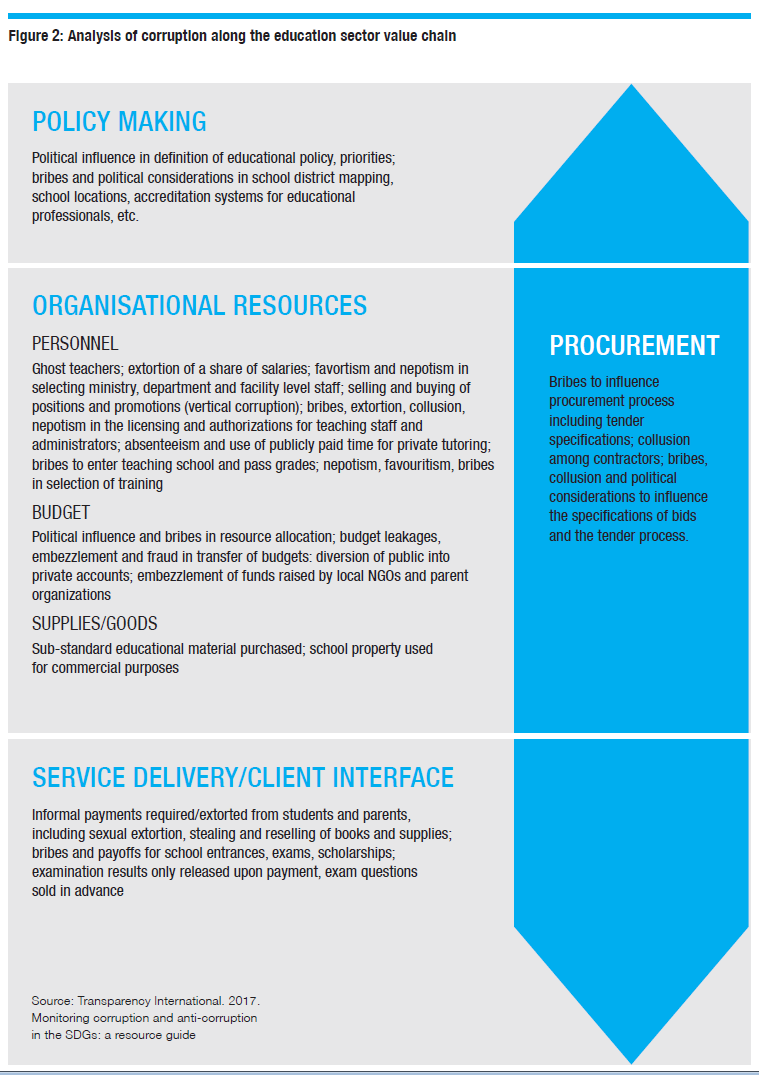Forms of corruption in education
While corruption in education is widespread in many countries, education sector corruption diagnostics are often inadequate, and more resources would need to be allocated to measure the scope and scale of corruption in this sector.[1]
Corruption risks in education are the result of two main characteristics of the sector. Firstly, the stakes at play in educational attainment can be very high. The “opportunity cost” involved in failed exams or acceptance to prestigious schools, which potentially bestow enormous future benefits to successful students, mean that some are prepared to compromise on integrity. Transparency International Vietnam found that a striking 38 per cent of young people surveyed stated they would be prepared to pay a bribe to get into a good school, while 16 per cent would be ready to bribe their teacher to pass an exam.[2]
Secondly, the large sums allocated to the education sector combined with often weak oversight structures make it a tempting target for those looking to commit fraudulent activity.[3] As such, while corruption is more visible at the point of service where teachers, professors and students interact, it can take many forms in the education sector and occurs at all stages of the service delivery chain, from school planning and management, student admissions and examinations, to academic research as well as to teachers’ management and professional conduct. There are particular areas of concerns at the policy formulation stage, as well as the management of organisational resources and the service delivery phases, as illustrated in the diagram below.

Massive cheating in Bihar, India
Such willingness provides the supply side of corruption and can generate petty bribery of staggering proportions, such as in the northern Indian state of Bihar where there is a highly organised, well-known and widely accepted system by which teachers, administrators, students, parents and middlemen collude to rig examinations on a massive scale.[4] As a rigged paper costs around US$600, the system further disadvantages those unable to afford to cheat. After footage emerged of family members scaling the walls of the examination hall to hand cheat sheets to students inside, the authorities launched a crackdown.[5] Revealingly, pass rates for these examinations immediately plummeted from around 75 per cent to 50 cent.[6]
Footnotes
- [1]
UNDP. 2011. Fighting Corruption in the Education Sector: Methods, Tools and Good Practices. http://www.undp.org/content/da...
- [2]
Towards Transparency Vietnam. 2011. Youth Integrity in Vietnam: Piloting Transparency International Youth Integrity Surveys. https://towardstransparency.vn/wp-content/uploads/2014/07/YIS-2011-Summary_FINAL_EN.pdf
- [3]
Transparency International. 2013. Global Corruption Report: Education. https://www.transparency.org/gcr_education
- [4]
BBC. 2014. The Students Who Feel They Have the Right to Cheat. http://www.bbc.com/news/magazine-29950843
- [5]
BBC. 2015. India Students Caught 'Cheating' in Exams in Bihar. http://www.bbc.com/news/world-asia-india-31960557
- [6]
BBC. 2016. Why Cracking Down on Cheating in India's Bihar State is Tough. http://www.bbc.com/news/world-asia-india-36431885
Chapters
Author
Iñaki Albisu Ardigó; Marie Chêne
Reviewer:
Matthew Jenkins
Contributing experts:
Umrbek Allakulov (Water Integrity Network)
Shaazka Beyerle (US Institute of Peace)
Simone Bloem (Center for Applied Policy)
Claire Grandadam (Water Integrity Network)
Jacques Hallak (Jules Verne University – Amiens)
Mihaylo Milovanovitch (Centre For Applied Policy)
Muriel Poisson (International Institute for Educational Planning (IIEP-UNESCO)
Juanita Riano (Inter-American Development Bank)
Marc Y. Tassé (Canadian Centre of Excellence for Anti-Corruption)
Vítězslav Titl (University of Siegen)
Davide Torsello (Central European University Business School)
Patty Zakaria (Royal Roads University)
Date
01/09/2017
